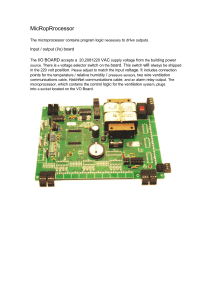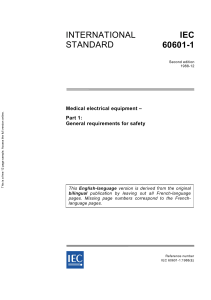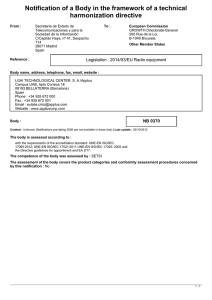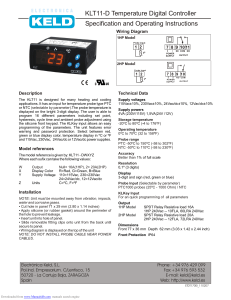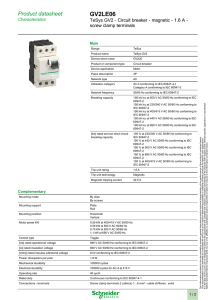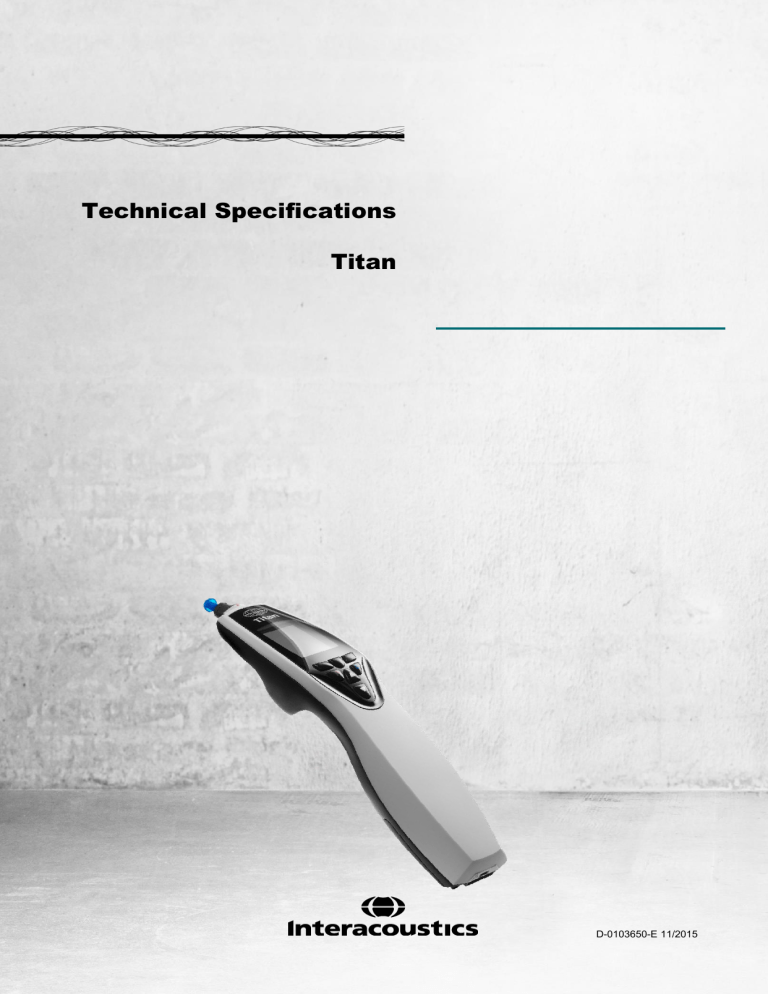
Technical Specifications Titan D-0103650-E 11/2015 Contents Titan Specifications......................................................................................................................... 1 1.1 Titan Software Module & Version Overview........................................................................ 1 1.1.1 IMP440 – Impedance Module ................................................................................ 1 1.1.2 ABRIS440 – Auditory Brainstem Response Infant Screening Module................... 1 1.1.3 DPOAE440 – Distortion Product Otoacoustic Emissions Module......................... 2 1.1.4 TEOAE440 – Transient Evoked Otoacoustic Emissions Module........................... 2 1.2 Included and Optional Parts ................................................................................................ 3 1.3 Titan Hardware – Technical Specifications ......................................................................... 4 1.4 Electromagnetic Compatibility (EMC) ............................................................................... 14 Titan Specifications Page 1 Titan Specifications 1.1 1.1.1 Titan Software Module & Version Overview IMP440 – Impedance Module Test types/functionality: Tympanometry 226Hz – Automatic (flexible start and stop pressure) Tympanometry 226Hz – Manual Acoustic reflex with single intensities or reflex growth – ipsilateral (automatic) Acoustic reflex with single intensities or reflex growth – contralateral (automatic) Manual control of all reflex functions Reflex decay, automatic 10 dB above threshold or manually controlled with stimulus duration of 10 up to 30 seconds Reflex latency, automatic 10 dB above threshold or manually controlled, first 300 ms from stimulus start ETF 1 – Non-perforated eardrum (William’s test) ETF 2 – Perforated eardrum (Toynbee test) ETF 3 – Patulous Eustachian tube (Sensitive baselinex tympanometry for 10 up to 60 seconds) High frequency probe tones (678, 800 & 1000 Hz) Wideband absorbance Wideband 3D tympanometry Wideband research module User customizable protocols Protocol upload Client/session upload/download PC-controlled testing Bluetooth Test types/functionality: 1.1.2 Screener X Diagnostic X Clinical x x x x x x x x x x x x x Optional x x x Optional x Screener x x x x Optional Optional Optional Optional x x x x x x Optional Optional Optional x x x x x Diagnostic Clinical ABRIS440 – Auditory Brainstem Response Infant Screening Module Functionality: Click stimulus CE-Chirp® stimulus Hi-Lo CE-Chirp® stimulus Stimulus intensity Bayesian weighted averaging Residual noise limit (as stop criteria) Test time Test montage Test method Enable pass/refer User customizable protocols Protocol upload Client/session upload/download PC-controlled testing Bluetooth Screener x x x 30, 35, 40dB nHL x x 1 – 10 minutes (default = 3 minutes) mastoid or nape monaural or binaural x x x x x x Titan Specifications 1.1.3 DPOAE440 – Distortion Product Otoacoustic Emissions Module Test types/functionality: Tympanometry 226Hz Tympanometry 1000Hz Frequency range Test points (frequencies) DP-Gram DP Input/Output Pressurized DPOAE Enable pass/refer Normative data (view, edit, import, export) Manual testing (add test points, extend testing) User customizable protocols Protocol upload Client/session upload/download PC-controlled testing Bluetooth 1.1.4 Page 2 Screener x Clinical x 500 – 6000 Hz Max 6 per test x 500 – 10000 Hz Unlimited x x x x x x x x x x x Optional x x x x x Optional x Optional TEOAE440 – Transient Evoked Otoacoustic Emissions Module Test types/functionality: Tympanometry 226Hz Tympanometry 1000Hz Frequency range Test time Stimulus intensity Center band frequencies (1, 1.5, 2, 3, 4) Custom band frequencies (user definable) Pressurized TEOAE FFT Display Enable pass/refer Normative data (view, edit, import, export) Manual testing (extend testing) User customizable protocols Protocol upload Client/session upload/download PC-controlled testing Bluetooth Screener x Clinical x Optional 1000 – 4500 Hz Max 6 minutes or 4500 sweeps 500 – 5500 Hz Unlimited 60 – 84 dB SPL x sweeps 4500 30 – 90 dB SPL x x x x x x x x x x x x Optional x x x x x Optional x Titan Specifications 1.2 Page 3 Included and Optional Parts The system consists of the following included and options parts: IMP440 Included parts: Titan handheld unit with basic probe Power supply (with converter) BET55 Ear tips Lithium Battery 4 cavities (0.2, 0.5, 2 and 5cc) Titan PC suite with IMP440 Instructions for Use TCB Carrying Bag USB cable, USB adaptor Included parts with diagnostic & clinical versions: Cradle Clinical probe extension CIR55 contra insert headset OtoAccess™ database Optional parts: Short probe extension Sanibel MTP-II Thermal printer DD45C contra cup headset EARtone 3A insert headset for contra Cradle Clinical probe extension OtoAccess™ database WBT calibration kit DPOAE440 Included parts: Titan handheld unit with basic probe Cradle Power supply (with converter) Clinical probe extension BET55 Ear tips Lithium Battery 4 cavities (0.2, 0.5, 2 and 5cc) Titan PC suite with DPOAE440 OtoAccess™ database USB cable, USB adaptor Instructions for Use TCB Carrying Bag Included parts with screener version: Eartip 3-5mm flanged (25 pcs.) Eartip 4-7mm flanged (25 pcs.) Eartip 5-8mm flanged (25 pcs.) Optional parts: Short probe extension Sanibel MTP-II Thermal printer ABRIS440 Included parts: Titan handheld unit with basic probe Cradle Power supply (with converter) PreAmplifier w/clothing clip & neckstrap Montage stickers Short extension cable ETSE tab surface electrode cables Pinch style electrode cables Sanibel tab surface electrodes (36 pcs.) Sanibel snap surface electrodes (36 pcs.) SPG15 preparation gel Alcohol pads, Gauze swabs USB cable, USB adaptor BET55 Ear tips Eartip 3-5mm flanged (25 pcs.) Eartip 4-7mm flanged (25 pcs.) Eartip 5-8mm flanged (25 pcs.) Lithium Battery 4 cavities (0.2, 0.5, 2 and 5cc) Titan PC suite with ABRIS440 OtoAccess™ database Instructions for Use TCB Carrying Bag Optional parts: EARtone ABR stereo ID earphones EarTone EarCup stereo ID transducer Sanibel MTP-II Thermal printer TDH39 Stereo ID headset DD45 stereo ID headset TEOAE440 Included parts: Titan handheld unit with basic probe Cradle Power supply (with converter) Clinical probe extension BET55 Ear tips Lithium Battery 4 cavities (0.2, 0.5, 2 and 5cc) Titan PC suite with DPOAE440 OtoAccess™ database USB cable, USB adaptor Instructions for Use TCB Carrying Bag Included parts with screener version: Eartip 3-5mm flanged (25 pcs.) Eartip 4-7mm flanged (25 pcs.) Eartip 5-8mm flanged (25 pcs.) Optional parts: Short probe extension Sanibel MTP-II Thermal printer Titan Specifications 1.3 Page 4 Titan Hardware – Technical Specifications Medical CE-mark Standards Cradle Battery Operation environment Transport & Storage The CE-mark indicates that Interacoustics A/S meets the requirements of Annex II of the Medical Device Directive 93/42/EEC. Approval of the quality system is made by TÜV – identification no0123 Safety: IEC 60601-1, Internally powered, Type B and BF applied parts EMC: IEC 60601-1-2 Impedance: IEC 60645-5/ANSI S3.39, Type 1 Test Signal: IEC 60645-1/ANSI S3.6 , IEC 60645-3 OAE: IEC 60645-6 2009, Type 2 Otoacoustic emissions ABR: IEC 60645-7 2009, Type 2 Safety: IEC 60601-1, Class II Power Astrodyne ASA30M-0301 or UE24WCP 100 – 240 VAC, 47 – 63 Hz Mains voltages and frequencies: Consumption: 0.8 – 0.4 A Use only: Temperature: Relative Humidity: Ambient Pressure: Warm-up Time: Storage Temperature: Transport Temperature: Rel. Humidity: NP120 or CGA103450 15 – 35 C 30 – 90% 98kPa – 104kPa 1 minute 0C – 50C -20 – 50 C 10 – 95% Impedance Measuring System Probe tone Frequency: Level: Air pressure Control: Indicator: Range: Pressure limitation: Pressure change rate: Compliance Range: Test types Tympanometry Indicators Eustachian tube function 1 – Non perforated eardrum Eustachian tube function 2 – Perforated eardrum Eustachian tube function 3 – Patulous Eustachian tube Graphical display Memory Tympanometry: Classic tympanometry: 226 Hz, 678 Hz, 800 Hz, 1000 Hz; pure tones; AGC controlled to protect for loud probe tone stimuli in small ear canals. WBT: 226 Hz – 8000 Hz broadband stimulus, 21.5/sec. 226 Hz: 85 dB SPL (≈ 69 dB HL) WBT: 96 dB peSPL (infant) / 100 dB peSPL (adult). (100 dB peSPL ≈ 65 dB nHL) Automatic. Measured value is displayed on the graphical display. -600 to +300 daPa. -750 daPa and +550 daPa. Minimum, medium, maximum or automatic with minimum speed at compliance peak. Selectable in the setup. 0.1 to 8.0 ml at 226 Hz probe tone (Ear volume: 0.1 to 8.0 ml) and 0.1 to 15 mmho at 678, 800 and 1000 Hz probe tone. Automatic, where the start and stop pressure can be userprogrammed in the setup function. Manual control of all functions. Williams test Toynbee test Continuous sensitive impedance measurement for 30 up to 150 s. Compliance is indicated as ml and pressure as daPa. In PC controlled mode admittance, susceptance and conductance can be printed. Stimulus level is indicated as dB Hearing Level. 1 curve per ear per tympanometry test. 3 curves per ear per Eustachian tube function test. And theoretically an infinite number of tests per protocol. There is no deviation between static and dynamic mode. Reflex Functions Signal sources Tone - Contra, Reflex: Tone - Ipsi, Reflex: NB noise - Contra, Reflex: 250, 500, 1000, 2000, 3000, 4000, 6000, 8000 Hz. 500, 1000, 2000, 3000, 4000 Hz. 250, 500, 1000, 2000, 3000, 4000, 6000, 8000 Hz. Titan Specifications Outputs Page 5 NB noise - Ipsi, Reflex: Noise - Contra, Reflex: Noise - Ipsi, Reflex: Contra Earphone: Ipsi Earphone: Test types Air: Manual Reflex Automated Reflex Reflex Decay Reflex latency 1000, 2000, 3000, 4000 Hz. Wide Band, High Pass, Low Pass. Wide Band, High Pass, Low Pass. TDH39 earphone, DD45 earphone, CIR55 insert and/or EARtone 3A insert for Reflex measurements. Probe earphone incorporated in the probe system for Reflex measurements. Connection of the air system to the probe. Manual control of all functions. Automatic reflexes: Single intensities Reflex growth Automatic, 10 dB above threshold and manually controlled with stimulus durations of 10 to 30 s. Automated, first 300 ms from stimulus start. ABR Infant Screening Preamplifier Electrical Impedance measurement Stimulus One Channel: Gain: Frequency response: Noise: CMR Ratio: Max input offset voltage: Input impedance: Power from main unit: Measurement frequency: Waveform: Measurement current: Range: Stimuli: Stimulus rate: Transducers: (Calibrated to Standards) Recording Channels: Level: Bandwidth: Analysis time: A/D resolution: Artifact reject system: Display Algorithmic Sensitivity Specificity CE-Chirp®: CE-Chirp®: 3 electrodes. 50 cm Switchable: Software will automatically switch mastoid and ground if mastoid montage is used. So the user does not need to replace electrode during testing. 64 dB 0,5 - 5000 Hz <25 nV/√Hz >90 dB. 2.5 V 10 MΩ/ 170 pF Isolated power supply 33 Hz Rectangular 11.25 μA 0.5 kΩ – 25 kΩ ± 10 % Click range (200 Hz -11 kHz) CE-Chirp® range (200 Hz – 11 kHz) HiLo CE-Chirp® range (Lo – up to 1.5 kHz) & (Hi – above 1.5 kHz) 90 Hz EARTone ABR insert phone EARTone ABR for EarCup TDH 39 or DD45 head phone (Static force: 4,5N ± 0,5N IOW Probe 2 30 dB nHL, 35 dB nHL, 40 dB nHL 22.05 kHz 1-10 min or Residual noise 5-80 nV 24 bit Rejection level (Peak, Min RMS, Max RMS) & Clipping (Saturation) Stimulus level and type, Bar and Graph view Basic and advanced view 99.9% > 96% Titan Specifications Page 6 DPOAE Stimulus Frequency range: Nominal frequency: Frequency step: Level: Level Step: Transducer: Recording Analysis time: A/D Resolution: Artifact rejection system: Stimulus tolerance: SNR criteria: Probe check window: DP-response window: Residual noise: Display General display gain: Display: Titan IOW probe: Probe specifications Other Test Pressure 500 to 10000 Hz f2 25 Hz 30 to 80 dB SPL (75 dB SPL for 6kHz and 65 dB SPL for 8kHz to 10kHz) 1 dB IOW Probe auto detection, auto calibrated Minimum 2 seconds to unlimited time 24 bit, 5.38 Hz resolution -30 to +30 dB SPL or off Adjustable between 1 and 10 dB Adjustable between 3 and 25 dB 256 points frequency response of the ear canal due to a click stimulus. 4096 points frequency response A RMS average measurement in the DP-bin frequency area (26 bins at frequencies < 2500 Hz & 60 bins ≥ 2500 Hz). Applicable during testing Stimulus level and type, Bar and Graph view IMP, DPOAE, TEOAE and ABRIS capable Replaceable probe tip Ambient pressure. Tympanic peak pressure. TEOAE Stimulus Recording Display Frequency range: Frequency step: Stimulus type: Level: Level step: Click rate: Stimulus tolerance: Transducer: Analysis time: A/D Resolution: Artifact rejection system: SNR criteria: TE criteria: Stimulus time window: Probe check window: Time recording window: Wave reproducibility window: Freq. response window: Other information: Probe specifications Other Test Pressure Titan IOW probe: 500 to 5500 Hz 1 Hz (Custom bands) Non-Linear and Linear (according to IEC 60645-3) 30 to 90 dB peSPL, peak to peak calibrated, AGC controlled 1 dB 43 – 100 Hz Adjustable between 1 and 3 dB IOW Probe auto detection, auto calibrated 5 seconds to unlimited time 24 bit 0 to +60 dB SPL or off Adjustable between 5 and 25 dB Band SNR, No. of Sweeps, Test time, Min Total OAE, Min Reproducibility - adjustable for use as test criteria 128 points instant recording of first click in sequence of clicks 256 points frequency response of the ear canal recorded click stimulus 3 – 23 msec (max). A and B buffer time-samples @ sampling rate 11025 Hz Adjustable inside the recording window 256 points frequency response, bin spacing 43 Hz In ear status (active during test), Noise level, Tympanic peak pressure Basic and Advanced view, FFT view, Test Summary view IMP, DPOAE TEOAE and ABRIS capable Replaceable probe tip Ambient pressure or tympanic peak pressure found in IMP module Titan Specifications Page 7 General PC control USB: Memory Thermal printer (Optional) Type: Paper width: Printing time: Dimensions Titan Weight ABR/OAE/IMP PreAmplifier weight ABR/OAE/IMP PreAmplifier dimensions OAE/IMP shoulder box weight OAE/IMP shoulder box dimensions Input/output for computer communication. Titan can be fully operated from a PC. The measurements can then be followed on the PC screen. Data can be sent to and saved on the PC and stored in OtoAccess™. See separate section in Service Manual for programming details. Theoretically, an infinite amount of test results can be stored on the PC. The Titan hand held unit is delivered with an 8 GB memory card, enough for storing more than a quarter of a million tests. Thermal (Bluetooth) printer with recording paper in rolls. Print on command through Bluetooth communication and through serial RS232. 57.5 ± 0.5 mm on thermal printer Printing time depends on the size of the used protocol. For 2 tympanograms and 8 reflexes the thermal printer uses approximately 6s. 6 x 6 x 28 cm / 2.4 x2.4 x11 inches 360 g / 0.8 lbs 120 g / 0.26 lbs 10.2 x 6.8 x 2.6 cm / 4 x 2.7 x 1 inches 64 g / 0.14lbs 6.5 x 3.5 x 1.8 cm / 2.6 x 1.4 x 0.7 inches Titan Specifications Page 8 Table 1: Frequencies and Intensity Ranges for IMP440 Titan Maximums IMP TDH39 CIR55 Reading EARtone 3A IOW IPSI Reading Reading DD45 Center Reading Freq. Tone NB Tone NB Tone NB Tone NB Reading [Hz] [dB HL] [dB HL] [dB HL] [dB HL] [dB HL] [dB HL] [dB HL] [dB HL] 125 80 65 85 70 100 85 70 60 250 100 85 100 85 110 100 85 75 500 120 100 110 100 115 105 100 85 750 120 105 110 105 120 110 100 85 1000 120 105 115 105 120 110 105 90 1500 120 105 115 105 120 110 110 90 2000 120 105 115 105 120 110 105 90 3000 120 105 115 105 120 110 95 90 4000 120 105 110 100 120 105 100 85 6000 120 100 95 95 105 100 85 80 8000 Tone [dB HL] 80 NB [dB HL] 65 100 85 115 100 120 105 120 105 115 100 115 100 125 105 115 105 110 90 105 95 105 95 80 85 90 85 80 75 WB - 120 - 120 - 120 - 105 - LP - 120 - 120 - 120 - 110 - HP - 120 - 120 - 120 - 105 - 10000 125 120 130 Table 2: Frequencies and Intensity Ranges for DPOAE440 Titan Maximums DPOAE IOW IPSI Reading IOW ch2 Reading Center Freq. [Hz] Tone Tone [dB SPL] [dB SPL] 500 80 80 750 80 80 1000 80 80 1500 80 80 2000 80 80 3000 80 80 4000 80 80 6000 75 75 8000 65 65 10000 65 65 Titan Maximums TEOAE Maximum TEOAE Click Intensity: 90 dB peSPL. Titan Maximums ABRIS Maximum ABRIS levels for Click and CE-Chirp® stimuli are limited to 30, 35 & 40 dBnHL for all transducers. Titan Specifications Page 9 Specification of input/output connections Inputs Patient response Connector type Jack, 3,5mm 4pole Electrical properties Handheld switch: Pin 1: GND Pin 2: Signal Pin 3: Future use I/O Pin 4: Future use I/O 3V through 10K is forced to ground when activated Outputs Phones, Left/ Right Jack, 3,5mm 4pole Up to 3V rms. by 10 load 8 Pin 3: Phones, Contralateral Up to 3V rms. by 10 load 8 Transducer Data I/O USB Voltage: Min. load impedance: Pin 1: CH1 GND Pin 2: CH1 OUT (left) Pin 3: CH2 OUT (right) Pin 4: CH1 GND Jack, 3,5mm 4Voltage: pole Min. load impedance: Pin 1: CH1 GND Pin 2: CH1 OUT (left) Pin 3: CH2 OUT (right) Pin 4: CH1 GND IA proprietary, 12- Pin 1: pole Pin 2: Pin 3: Pin 4: Pin 5: Pin 6: Pin 7: Pin 8: Pin 9: Pin 10: Pin 11: Pin 12: USB type”B” USB port for communication CH1 out CH1 GND DGND GND A / GND Microphone Microphone – input / Analog balanced in Microphone + input / Analog balanced in Power supply +3/+5V CH2 out CH2 GND I2C CLK I2C DATA I2C Interrupt Titan Specifications Page 10 Calibration Properties Telephonics TDH39 with a static force of 4.5N 0.5N and/or EARtone 3A and/or CIR55 insert phone Probe system: Ipsilateral Earphone: is integrated in the probe system Probe frequency transmitter and receiver and pressure transducer is integrated in the probe system Accuracy General: Generally the instrument is made and calibrated to be within and better than the tolerances required in the specified standards: Reflex Frequencies: 1% Contralateral Reflex and 3 dB for 250 to 4000Hz and 5 dB for 6000 to Audiometer Tone Levels: 8000Hz Ipsilateral Reflex Tone 5 dB for 500 to 2000Hz and +5/-10 dB for 3000 to Levels: 4000Hz DPOAE Levels: 1.5 dB for 1000 to 4000Hz and 3 dB outside range 2 dB for click stimulus TEOAE Levels: ABRIS Levels: 2 dB for all stimulus types Pressure measurement : 5% or 10 daPa, whichever is greater Compliance measurement: 5% or 0.1 ml, whichever is greater Stimulus Presentation Reflexes: ON-OFF ratio = ≥ 70 dB Control Rise time = 27 ms Fall time = 24.6 ms A weighted SPL in Off = 31 dB Calibrated Transducers Contralateral Earphone: Impedance Calibration Properties Probe tone Frequencies: Level: Compliance Distortion: Range: Temperature dependence: Pressure dependence: Reflex sensitivity: Reflex artifact level: Temporal reflex characteristics: Pressure Range: Safety limits: 226 Hz 1%, 678 Hz 1%, 800 Hz 1%, 1000 Hz 1% 85 dB SPL 1.5 dB measured in an IEC 60318-5 acoustic coupler. The level is constant for all volumes in the measurement range. Max 1% THD 0.1 to 8.0 ml -0.003 ml/C -0.00020 ml/daPa 0.001 ml is the lowest detectable volume change ≥95 dB SPL (measured in the 711 coupler, 0.2 ml, 0.5 ml, 2.0 ml & 5.0 ml hardwalled cavities). Initial latency = 35 ms (5 ms) Rise time = 45 ms (5 ms) Terminal latency = 35 ms (5 ms) Fall time = 45 ms (5 ms) Overshoot = max. 1% Undershoot = max 1% Values between -600 to +300 daPa can be selected in the setup. -750 daPa and +550 daPa, 50 daPa Titan Specifications Page 11 Reflex Calibration Standards and Spectral Properties: General Contralateral Earphone Specifications for stimulus and audiometer signals are made to follow IEC 60645-5 Pure tone: Wide Band noise (WB): Spectral properties: ISO 389-1 for TDH39 and ISO 389-2 for CIR 55. Interacoustics Standard As “Broad band noise” specified in IEC 60645-5, but with 500 Hz as lower cut-off frequency. Low Pass noise (LP): Interacoustics Standard Uniform from 500 Hz to 1600 Hz, 5 dB re. 1000 Hz Spectral properties: level High Pass noise (HP): Interacoustics Standard Uniform from 1600 Hz to 10KHz, 5 dB re. 1000 Hz Spectral properties: level Ipsilateral Earphone Pure tone: Interacoustics Standard. Wide Band noise (WB): Interacoustics Standard As “Broad band noise” specified in IEC 60645-5, but Spectral properties: with 500 Hz as lower cut-off frequency. Low Pass noise (LP): Interacoustics Standard Uniform from 500 Hz to 1600 Hz, 10 dB re. 1000 Hz Spectral properties: level High Pass noise (HP): Interacoustics Standard Uniform from 1600 Hz to 4000 Hz, 10 dB re. 1000 Hz Spectral properties: level General about levels: The actual sound pressure level at the eardrum will depend on the volume of the ear. See Table 2 for details. The risk of artifacts at higher stimulus levels in reflex measurements are minor and will not activate the reflex detection system Titan Specifications Page 12 Table 3: Reference Values for Stimulus Calibration Freq. Reference values for stimulus calibration Variation of Ipsi stimulus levels for different volumes of the ear canal Relative to the calibration performed on an IEC 126 coupler [dB] 0.5 ml 1 ml 26 14 5.5 0 2 3 3.5 5.5 2 0 26 14 5.5 0 2 3 3.5 5.5 2 0 47.5 27 13 6 8 8 8 9 20.5 12 41 24.5 9.5 6.5 5 12 11 3.5 3 -5 WB LP HP -8 -6 -10 -5 -7 -8 -5 -7 -8 -8 -6 -10 -5 -7 -8 CEChirp CEChirp Low CEChirp High Click 27.5 31.5 26 26.5 26.5 25.5 50 27.5 28 31 28 32 30.5 35 32.5 61.5 33.5 58.5 32 58 *All figures in bold are Interacoustics Standard values. ISO 389-4 (ISO 8798) 45 25.5 11.5 7 6.5 9 10 9.5 15.5 13 DD45 Ear IOW Cups Probe Interacoustics Standard 125 250 500 1000 1500 2000 3000 4000 6000 8000 Interacoustics Standard TDH39 Interacoustics Standard [Hz] EARtone CIR55 3A / ABR Interacoustics Standard ISO 389-2 (Interacoustics Standard) ISO 382-2 (Interacoustics Standard) ISO 389-1 (Interacoustics Standard) peRETSPL RETSPL [dB re. 20 µPa] Sound attenuation values for TDH39 earphones using MX41/AR or PN51 cushion [dB] IOW NB Probe Stimulus NB Correction Values (except IOW probe) 43.5 4 26.5 4 17 4 6 10.5 12 6 11 6 11 6 8 5 5.5 5 -0.5 5 9.7 9.7 5.3 5.3 11.7 -0.8 -1.6 3.9 -0.5 -0.8 7.5 8.0 3.9 3.2 3.6 1.4 3 5 7 15 21 (1600Hz) 26 31 (3150Hz) 32 26 (6300Hz) 24 Titan Specifications Page 13 Coupler Types used for Calibration IMP: TDH39 is calibrated using a 6cc acoustic coupler made in accordance to IEC 60318-3, Ipsilateral earphone and probe tone are calibrated using a 2cc acoustic coupler made in accordance to IEC 60318-5 ABRIS: Probe and insert stimuli are calibrated in SPL values using an ear simulator coupler made in accordance to IEC 60318-4. Headphones (TDH39 and DD45) stimuli are calibrated in SPL values using an artificial ear coupler according to IEC 60318-1. DPOAE: Probe stimuli L1 and L2 are calibrated individually in SPL values using the IEC 711 ear simulator coupler made in accordance to IEC 60318-4. TEOAE: Probe stimuli are calibrated in peSPL values using the IEC 711 ear simulator coupler made in accordance to IEC 60318-4. General Information about Specifications Interacoustics continuously strives to improve its products and their performance. Therefore the specifications can be subject to change without notice. The performance and specifications of the instrument can only be guaranteed if it is subject to technical maintenance at least once per year. This should be carried out by a workshop authorized by Interacoustics. Interacoustics puts diagrams and service manuals at the disposal of authorized service companies. Enquiries about representatives and products may be sent to: Interacoustics A/S Phone: +45 63713555 Audiometer Alle 1 Fax: +45 63713522 5500 Middelfart E-mail: info@interacoustics.com Denmark http: www.interacoustics.com Titan Specifications 1.4 Page 14 Electromagnetic Compatibility (EMC) Portable and mobile RF communications equipment can affect the TITAN . Install and operate the TITAN according to the EMC information presented in this chapter. The TITAN has been tested for EMC emissions and immunity as a standalone TITAN . Do not use the TITAN adjacent to or stacked with other electronic equipment. If adjacent or stacked use is necessary, the user should verify normal operation in the configuration. The use of accessories, transducers and cables other than those specified, with the exception of servicing parts sold by Interacoustics as replacement parts for internal components, may result in increased EMISSIONS or decreased IMMUNITY of the device. Anyone connecting additional equipment is responsible for making sure the system complies with the IEC 60601-1-2 standard. Guidance and manufacturer’s declaration - electromagnetic emissions The TITAN is intended for use in the electromagnetic environment specified below. The customer or the user of the TITAN should assure that it is used in such an environment. Emissions Test Compliance Electromagnetic environment - guidance RF emissions Group 1 The TITAN uses RF energy only for its internal function. CISPR 11 Therefore, its RF emissions are very low and are not likely to cause any interference in nearby electronic equipment. RF emissions Class B The TITAN is suitable for use in all commercial, industrial, business, and CISPR 11 residential environments. Harmonic emissions Complies IEC 61000-3-2 Class A Category Voltage fluctuations / Complies flicker emissions IEC 61000-3-3 Recommended separation distances between portable and mobile RF communications equipment and the TITAN . The TITAN is intended for use in an electromagnetic environment in which radiated RF disturbances are controlled. The customer or the user of the TITAN can help prevent electromagnetic interferences by maintaining a minimum distance between portable and mobile RF communications equipment (transmitters) and the TITAN as recommended below, according to the maximum output power of the communications equipment. Rated Maximum output Separation distance according to frequency of transmitter power of transmitter [m] [W] 150 kHz to 80 MHz 80 MHz to 800 MHz 800 MHz to 2.5 GHz d = 1.17√𝑃 d = 1.17√𝑃 d = 2.23√𝑃 0.01 0.12 0.12 0.23 0.1 0.37 0.37 0.74 1 1.17 1.17 2.33 10 3.70 3.70 7.37 100 11.70 11.70 23.30 For transmitters rated at a maximum output power not listed above, the recommended separation distance d in meters (m) can be estimated using the equation applicable to the frequency of the transmitter, where P is the maximum output power rating of the transmitter in watts (W) according to the transmitter manufacturer. Note 1 At 80 MHz and 800 MHZ, the higher frequency range applies. Note 2 These guidelines may not apply to all situations. Electromagnetic propagation is affected by absorption and reflection from structures, objects and people. Guidance and Manufacturer’s Declaration - Electromagnetic Immunity The TITAN is intended for use in the electromagnetic environment specified below. The customer or the user of the TITAN should assure that it is used in such an environment. Immunity Test IEC 60601 Test Compliance Electromagnetic level Environment-Guidance Electrostatic Discharge +6 kV contact +6 kV contact Floors should be wood, concrete or (ESD) ceramic tile. If floors are covered with +8 kV air +8 kV air synthetic material, the relative humidity IEC 61000-4-2 should be greater than 30%. Electrical fast transient/burst +2 kV for power supply lines +2 kV for power supply lines +1 kV for input/output lines +1 kV for input/output lines Surge +1 kV differential mode +1 kV differential mode IEC 61000-4-5 +2 kV common mode +2 kV common mode Voltage dips, short interruptions and voltage variations on power supply lines < 5% UT (>95% dip in UT) for 0.5 cycle 40% UT (60% dip in UT) for 5 cycles 70% UT (30% dip in UT) for 25 cycles <5% UT (>95% dip in UT) for 5 sec < 5% UT (>95% dip in UT) for 0.5 cycle 40% UT (60% dip in UT) for 5 cycles 70% UT (30% dip in UT) for 25 cycles <5% UT Mains power quality should be that of a typical commercial or residential environment. If the user of the TITAN requires continued operation during power mains interruptions, it is recommended that the TITAN be powered from an uninterruptable power supply or its battery. 3 A/m 3 A/m Power frequency magnetic fields should be at levels characteristic of a typical location in a typical commercial or residential environment. IEC61000-4-4 IEC 61000-4-11 Power frequency (50/60 Hz) IEC 61000-4-8 Note: UT is the A.C. mains voltage prior to application of the test level. Mains power quality should be that of a typical commercial or residential environment. Mains power quality should be that of a typical commercial or residential environment. Titan Specifications Page 15 Guidance and manufacturer’s declaration — electromagnetic immunity The TITAN is intended for use in the electromagnetic environment specified below. The customer or the user of the TITAN should assure that it is used in such an environment, Immunity test IEC / EN 60601 Compliance level Electromagnetic environment – guidance test level Portable and mobile RF communications equipment should be used no closer to any parts of the TITAN , including cables, than the recommended separation distance calculated from the equation applicable to the frequency of the transmitter. Recommended separation distance Conducted RF IEC / EN 61000-4-6 Radiated RF IEC / EN 61000-4-3 3 Vrms 150kHz to 80 MHz 3 V/m 80 MHz to 2,5 GHz 3 Vrms d 1,2 P d 1,2 P 3 V/m 80 MHz to 800 MHz d 2,3 P 800 MHz to 2,5 GHz Where P is the maximum output power rating of the transmitter in watts (W) according to the transmitter manufacturer and d is the recommended separation distance in meters (m). Field strengths from fixed RF transmitters, as determined by an electromagnetic site survey, (a) should be less than the compliance level in each frequency range (b) Interference may occur in the vicinity of equipment marked with the following symbol: NOTE1 At 80 MHz and 800 MHz, the higher frequency range applies NOTE 2 These guidelines may not apply in all situations. Electromagnetic propagation is affected by absorption and reflection from structures, objects and people. (a) Field strengths from fixed transmitters, such as base stations for radio (cellular/cordless) telephones and land mobile radios, amateur radio, AM and FM radio broadcast and TV broadcast cannot be predicted theoretically with accuracy. To assess the electromagnetic environment due to fixed RF transmitters, an electromagnetic site survey should be considered. If the measured field strength in the location in which the TITAN is used exceeds the applicable RF compliance level above, the TITAN should be observed to verify normal operation, If abnormal performance is observed, additional measures may be necessary, such as reorienting or relocating the TITAN . (b) Over the frequency range 150 kHz to 80 MHz, field strengths should be less than 3 V/m. Titan Specifications Page 16 To ensure compliance with the EMC requirements as specified in IEC 60601-1-2, it is essential to use only the following accessories: ITEM Clinical Probe Extension Short Probe Extension ABRIS Preamplifier CIR55 Insert Phone TDH39C Contra Headset DD45C Contra Headset EARTone 3A with Minijack CIR55 Contra ID Earphone TDH39C Contra ID Headset DD45C Contra ID Headset EARTone 3A Contra ID Earphone TDH39 Stereo ID headset DD45 Stereo ID headset EARTone ABR Stereo ID Headset EarCup Stereo ID Headset MANUFACTURER Interacoustics Interacoustics Interacoustics Interacoustics Interacoustics Interacoustics Interacoustics Interacoustics Interacoustics Interacoustics Interacoustics Interacoustics Interacoustics Interacoustics Interacoustics MODEL CIR55 TDH39C DD45C Ear3A CIR55 TDH39C DD45C Ear3A TDH39 TDH39 Ear3A Ear3A Conformance to the EMC requirements as specified in IEC 60601-1-2 is ensured if the cable types and cable lengths are as specified below: Description Mains Cable USB Cable PSU USB Adapter Clinical Probe Extension Short Probe Extension ABRIS Preamplifier CIR55 Insert Phone TDH39C Contra Headset DD45C Contra Headset EARTone 3A with Minijack CIR55 Contra ID Earphone TDH39C Contra ID Headset DD45C Contra ID Headset EARTone 3A Contra ID Earphone TDH39 Stereo ID headset DD45 Stereo ID headset EARTone ABR Stereo ID Headset EarCup Stereo ID Headset Length 2.0m 2.0m 0.1m 2.0m 0.4m 2.0m 0.4m 0.5m 0.5m 0.5m 0.4m 0.5m 0.5m 0.5m 0.5m 0.5m 0.5m 0.5m Screened? Unscreened Screened Screened Unscreened Unscreened Unscreened Screened Screened Screened Screened Screened Screened Screened Screened Screened Screened Screened Screened Essential performance For this product the following is considered essential performance: To generate and present stimulus signals in the audio range as specified in the applicable IEC 60645 series in normal condition Record and store patient responses
